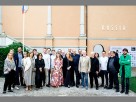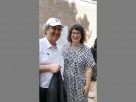Venice Architecture Biennial 2018
Event Venue:
Giardini della BiennaleVenice, Italy
Event Date:
May 26 - Nov 25, 2018Biennale Architettura 2018 is titled FREESPACE, a word which describes a generosity of spirit and a sense of humanity at the core of architecture's agenda.
Read Dr. Regina Khidekel's article "If it were not for railways, Vitebsk would not have become the Paris of the East. From the archive of Lazar Khidekel | Если бы не железные дороги...Витебск не стал бы Парижем востока. Из архива Лазаря Хидекеля" was published in the exhibition's catalog.
An artist’s archive is a peculiar storage chamber not only of historical documents, but also of ideas. And if it is the archive of a Suprematist artist and architect, the relevance of these ideas continues to grow, as is the case with Lazar Khidekel – the ‘revolutionary Suprematist’ in art and urbanist movement, whose futuristic cities of the mid 1920s are only today beginning to be recognised for their genius and foresight. Daniel Liebeskind called Lazar Khidekel a prophet, but the whole galaxy of new architects including Zaha Hadid, Rem Koolhaas and their successors, has been relying architecturally on Suprematism, including the intuitive insights of a single Suprematist architect: Lazar Khidekel. Our new contributor, Dr. Regina Khidekel, has kindly offered her essay on the Vitebsk School which has first been published in the catalogue of the current architectural Venice Biennale with Freespace as its main theme. No other subject could be more appropriate for Lazar Khidekel, who is known to open up new horizons of thought and perspectives for architects of the past and, especially, present. With exhibitions currently on view at the Centre Pompidou and Museum Guggenheim Bilbao, it is an opportune moment to look once again at the role of the Vitebsk School and its place in the Russian and world history of art and architecture.
I am looking at a photograph that has become emblematic of the international avant-garde. It was taken on June 5, 1920. The UNOVIS[1] group at Vitebsk Art School was setting off for the First Conference of Teachers and Students of Art in Moscow. The teachers were Kazimir Malevich, vigorously gesticulating with a Suprematist circle, a tondo, pressed to his chest; El Lissitsky, Vera Ermolaeva, and Nina Kogan. The students were in the foreground. One of the more striking figures was Lazar Khidekel, whose determined gaze seemingly challenged the old art. He was joined by Mikhail Kunin, Ilya Chashnik, and Lev Yudin, among others. All of them stood in front of a heated freight car, decorated with Suprematist banners.
This is one of the most significant photographs of UNOVIS. The idea of a laboratory for collective creativity found appropriate expression in the image of the heated freight car, in which all were equal. Teachers and students would not disperse to their compartments: they would travel together. Aligned vertically, the photograph is saturated with the dynamism of movement, conveying the sense of action interrupted for a second just before the train headed off into the future.
There are many stories surrounding the trips made by UNOVIS. In one of them, Khidekel was left behind by the train. He ran to get boiling water and found himself stranded on the platform. He was taken to the stationmaster, who interrogated him. When the stationmaster heard the adolescent was an artist, he asked him to prove it and draw his portrait. Satisfied with the drawing’s speed and accuracy, he personally put Khidekel on a train to catch up with his comrades.
UNOVIS went to Moscow and Smolensk, where a branch was established. When the curriculum was completed in May 1922, Malevich, Khidekel, and Chashnik set out for Petrograd.
Railway trips were the preludes to many stories. In November 1919, Lissitsky brought Malevich to Vitebsk from Moscow, while in the mid 1920s, alas, Malevich likewise asked Lissitsky to take him to Europe.
The flourishing of the Vitebsk Art School, founded by Chagall in 1918, and the fame of Vitebsk as an international art center from 1918 to 1922, was bound up with the railways connecting East and West. Driven by famine from Russia, then devastated by the Civil War, cultural producers arrived in the relatively peaceful and well-fed city on the old Russian Empire’s western frontier. Some planned to stay there temporarily, while others stopped there in transit before leaving Russia forever. Both groups of people contributed to the growth of the Vitebsk Art School and the city’s culture.
Railroads had revolutionized the world and Russia. They played a tremendous role in Vitebsk. They were a powerful emotional factor in encouraging a sense of expanding space, of the city’s connections with the rest of the country and the huge world beyond it. This was vital to the development of Suprematism, a new trend in art combining philosophy and science that with the advent of UNOVIS in Vitebsk, gained the status of an avant-garde school and laboratory, thus anticipating the Bauhaus.
The Khidekel family lived in the vicinity of the railway station. It was a custom among the residents of Vitebsk to go walking to the station to greet and see off trains. Used to a settled lifestyle, the townspeople had a chance at the station to see people moving freely around the world, people dressed in the latest fashions, inhabitants of another world, which beckoned and awakened dreams of breaking free of the daily grind. At the beginning of the 20th century, all restrictions on movement seemed a relic of the past and lagged behind the rhythm of industrial development even of Russia itself.
Bella Rosenfeld, soon to be Bella Chagall, recalled her sense Vitebsk was at the edge of the world. As a girl, she would run to the station to see that the trains were not travelling in two directions. Indeed, designed by English engineers in the 1860s, but not entirely happily, this segment of the future Riga–Oryol Railway was an inbound station only for a long time. All trains bound from Riga had to call at Vitebsk, change tracks, and only then head back out towards Oryol. In 1904, the St Petersburg–Tsarskoye Selo Line was extended to Vitebsk. This was the reason the railway station in the Russian Empire’s capital, built on the site of the country’s oldest station, Tsarskoye Selo Station, was dubbed Vitebsk Station. In 1909, Vitebsk was the first station in the Russian Empire equipped with a centralized electromechanical switching and signaling system.
Vokzalnaya (Station) Street was one of Vitebsk’s central arteries. It gave visitors a sense of the city’s character, and the goods and services available, as reflected in advertisements and shop signs. Vitebsk residents associated the street with the roar of trains, with movement, speed, progress, and dreams come true, the promise of long voyages, of the new and unknown.
As for Vitebsk art, Vokzalnaya Street was, presumably, a harbinger of the airport runway.
It inspired Chagall’s flight, the inexhaustible thirst to escape from the shackles of spatial limitations and take off, to fly away into the sky while forever preserving in your heart nostalgia and love for the place where you were born.
The railroads exerted a unique influence on Malevich’s emergence as an artist. Malevich worked as a draftsman in the Moscow–Kursk Railway Administration from 1896 to 1904. In his 1904 application for admission to the competitive entrance exams to the Moscow School of Painting, Sculpture, and Architecture, Malevich in the column marked “Address”, wrote, “Moscow–Kiev–Voronezh Railway Administration, City of Kursk. Track Maintenance Service.” Some have joked this was why Malevich preferred straight lines. More relevant is the circumstance that a view of the railways gave Malevich the opportunity to watch at length lines disappearing into the horizons, lines that gathered in a single point before vanishing over the horizon in the infinite sky space – the canvas. It was Malevich’s work as a draftsman on the railways that generated the geometric abstraction, a sense of overcoming gravity and a planetary vision that would determine Suprematist art.
“Locomotives, railroads, propellers, airplanes, and roaring cars are not steeds in a meadow. They are replete with movement and dynamism. This movement cries out for art,” wrote Malevich. In 1913, he produced the dynamic sketch Simultaneous Death of a Man in an Airplane and on the Railroad in the Cubo-Futurist style. It is curious that Malevich’s first article on the state of modern architecture, Architecture as a Slap in the Face to Reinforced Concrete (1918), was provoked by his disappointment with the new Kazan Station in Moscow. Malevich imagined that, formally, the station building should have embodied the new age of speed, whereas in fact Kazan Station was an incarnation of the eclectic historicist style that had prevailed in the 19th century. The railway is a “tunnel, the city’s nervous pulse and breath, its living vein and vibrating heart, life’s roaring volcano,” wrote Malevich, calling on architects to produce architecture in step with the times.
The railroads played a huge role in art. Their emergence in Russia encouraged the Wanderers, who took art exhibitions to places that had previously been bereft of art. New art schools, creative individuals, and independent art centers emerged. From 1918 to 1922, Vitebsk was one such center. It played its role in world history, leaving a deep imprint on modern visual culture.
[1] UNOVIS (1920–1924, “Affirmers of the New Art”) was a group established by students and teachers at the Vitebsk Art School and led by Kazimir Malevich.



